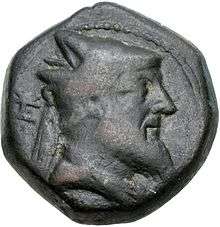Xerxes of Armenia
| Xerxes | |||||
|---|---|---|---|---|---|
 Coin of king Xerxes, from around 220 BC | |||||
| King of Sophene and Commagene | |||||
| Reign | 228 – 212 BC | ||||
| Coronation | 228 BC | ||||
| Successor | Abdissares, King of Sophene & Commagene | ||||
| Died |
212 BC Sophene | ||||
| Consort | Antiochis | ||||
| Issue |
Abdissares Zariadres | ||||
| |||||
| Dynasty | Orontid Dynasty | ||||
| Father | Arsames I | ||||
Xerxes (Armenian: Շավարշ – Šavarš, Ancient Greek: Ξέρξης - Xerxes, Old Persian: Ḫšayāršā) was satrap of the Seleucid territories of Sophene and Commagene from 228 BCE to 212 BCE, the year of his death.
He succeeded his father Arsames I to rule both Sophene and Commagene in 228 BC, while his brother Orontes IV ruled Armenia. In 223 BC, several Seleucid satraps rebelled against King Antiochus III, including Artabazanes (Upper Media), Molon (Lower Media), Alexander (Persis), and Achaeus (Asia Minor). By 220 BC Antiochus had put down most of the rebellions; however, Achaeus was not defeated until 213 BC.
These rebellions help explain Antiochus' subsequent aggressive policy toward his satrap Xerxes. By 212 BC, Antiochus III had invaded the domain of Xerxes and defeated him after laying siege to the city of Arsamosata. Shortly afterwards Antiochus III arranged for Xerxes to marry his sister, Antiochis. However, within the same year she arranged to have her new husband assassinated, thinking that her brother would then be able to take control of Sophene. Whether Xerxes still ruled Commagene by the time of his assassination is not known.
Antiochus III, however, distracted by his many military campaigns, preferred to place Sophene under the rule of Xerxes' son, Abdissares (Zareh).
See also
Notes
References
- Johann Gustav Droysen, Geschichte des Hellenismus, vol. ii. p. 73
- Joseph Hilarius Eckhel, vol. iii. p. 204.
- Richard G. Hovannisian, The Armenian People from Ancient to Modern Times, 2 vols. New York: St. Martin's Press, 1997